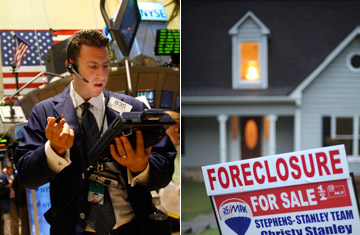
All debt issued by mortgage giants Fannie Mae and Freddie Mac comes with a prominent disclaimer: "Not guaranteed by the United States." But the business model of both companies, not to mention the continued functioning of the U.S. mortgage market, depends on nobody quite believing that disclaimer. Wrap your head around that contradiction, and you're well on your way to understanding the Fannie-Freddie drama currently gripping U.S. markets.
Shares in Freddie Mac are down 60% in the past three days; Fannie Mae is down about 45%. That's as of midday Friday; when markets opened for the day, the drop had been much worse, and the broader markets plunged likewise, with the Dow hitting a two-year low. The initial spark for the decline, at the beginning of the week, was a report from a Lehman Brothers analystsuggesting that new accounting rules might force the companies to go begging for $75 billion in capital. But what really sent the stocks into free-fall was the news — first reported in the Wall Street Journal — that Bush Administration officials have made contingency plans for responding to a scenario in which Fannie and Freddie could no longer pay their debts. Then, William Poole, until recently the president of the Federal Reserve Bank of St. Louis, pointed out in an interview with Bloomberg that Freddie Mac was already technically insolvent — it owes more than its assets are worth — and that Fannie Mae was headed in that direction.
The reason that the stock prices in both companies has plummeted, is that if the government had to step in to keep Fannie and Freddie functioning, shares in the companies would probably become worthless. On Friday morning, Treasury Secretary Hank Paulson issued a cryptic statement that seemed to say there wasn't any such bailout in the offing, and the stocks recovered slightly. Then word got out that Federal Reserve chairman Ben Bernanke had said the Fed would extend credit to Fannie and Freddie, and the stocks recovered more. But what happens next is anybodys guess.
Here's why it matters: Fannie and Freddie buy the bulk of the home loans made in this country. Most are repackaged as mortgage-backed securities, which they then sell to investors with the guarantee that they'll make up any shortfall. Others they keep in their portfolio, which they finance by selling bonds to investors. If the two companies were unable to keep buying home loans, the current housing crisis would get much, much worse. But if the federal government had to backstop them, the cost could run as high as $1.1 trillion.
Fannie Mae started life in 1938 as a government agency, the Federal National Mortgage Association, and was privatized in 1968. Congress created Freddie — the Federal Home Loan Mortgage Corp. — in 1970 to give it some competition. For years the two companies operated on the fringes of the mortgage market, which was dominated by savings & loan companies. But after the S&L collapse of the 1980s, Fannie and Freddie swept in to take over. The widespread assumption that government would step in if they faltered allowed them to borrow money at only slightly higher rates than the U.S. Treasury, which meant they could outbid all competitors in the secondary mortgage market. Before long 60% of all mortgages made in the U.S. were passing through their hands, and their share would have been even higher if they weren't banned from buying loans above a certain size ($417,000 in 2007) and generally required to stay away from exotic loans and borrowers with poor credit. For a time in the mid-1990s, before the wave of bank megamergers that brought us the likes of Citigroup and J.P. Morgan Chase, Fannie Mae was the biggest financial institution, by assets, in the country.
Fannie and Freddie did get lots of flak, mostly from people on the political right, for taking risks for which taxpayers might eventually have to foot the bill (and, from other quarters, for its top executives' outsized pay packages). Both companies also got tangled in accounting scandals in 2003 and 2004. But more shocking was what followed from 2004 through 2006: The two mortgage giants got muscled aside by Wall Street firms willing to underwrite bigger, riskier mortgages than Fannie and Freddie were allowed to touch. Their joint market share fell to only about 25% in 2006.
In other words, Fannie and Freddie were mostly bystanders to the worst excesses of the housing bubble. Since it popped, they and the more explicitly government-backed team of the Federal Housing Administration and Ginnie Mae (which buys FHA-insured loans) have been crucial to keeping the mortgage and housing markets going. In January, Congress raised Fannie's and Freddie's loan limit temporarily to as much as $729,750 to aid struggling high-priced housing markets on the coasts.
With house prices falling in most of the country, though, even the relatively safe loans acquired by Fannie and Freddie are starting to turn sour at much higher-than-expected rates. This doesn't necessarily mean they're doomed — far from it. "A lot of the problem that they're facing right now is just a lack of confidence and the market overreacting," says Bert Ely, a financial consultant in Alexandria, Va., and a long-time critic of Fannie and Freddie. "I don't think things are quite as dire for these companies in the short term as they're being made to appear."
But Ely also thinks that Fannie's and Freddie's charmed existence as private enterprises with tacit government backing can't continue. "What all this bailout talk does is blow away the notion that there's an 'implicit' guarantee. There is a guarantee, or there isn't."
